
Read one or more of the
following introductions: Hudson
River School, 'We Are Still in Eden': Iconography
of the Hudson River School, and/or Hudson
River School Painters.
All that is Glorious: Paintings
from the Hudson River School and American Eden: Landscape Paintings of the Hudson River School
--these two exhibit reviews are good introductions and have some images not available elsewhere.
See also: Hudson River Women's Art, Part II--examples of paintings by and information about some women painters of the Hudson River Valley School of painting.
Cole biography--linked to many images at the bottom of the page.

Thomas Cole, "The Falls of Kaaterskill" (1826).
Can you find the tiny human observer in the scene?
Large image available here.
A long narrative poem in a darker romantic mood, inspired by Cole's painting: William Cullen Bryant's Catterskill Falls.
Catterskill Falls (short excerpt)
by William Cullen Bryant
MIDST greens and shades the Catterskill leaps,
From cliffs where the wood-flower clings;
All summer he moistens his verdant steeps
With the sweet light spray of the mountain springs;
And he shakes the woods on the mountain side,
When they drip with the rains of autumn tide.
But when, in the forest bare and old,
The blast of December calls,
He builds, in the starlight clear and cold,
A palace of ice where his torrent falls,
With turret, and arch, and fretwork fair,
And pillars blue as the summer air.
For whom are those glorious chambers wrought,
In the cold and cloudless night?
Is there neither spirit nor motion of thought
In forms so lovely and hues so bright?
Hear what the gray-haired woodmen tell
Of this wild stream and its rocky dell. . . .

Thomas Cole, "View from Mt. Holyoke, Northampton, Massachusetts,
after a Thunderstorm (The Oxbow)" (1836).
Over 6 ft. wide. Large image available here.
That's the artist himself, bottom right of
center, on the ledge.

Thomas Cole, "The Course of Empires: The Savage State"
Large image available here.
According to this source, "'The Course of Empire' is
a five-part series of paintings created by Thomas Cole in the years 1833–36. . . . The series of paintings
depicts the growth and fall of an imaginary city. . . .
The first painting, 'The Savage State,' shows . . . [a] hunter clad
in skins hasten[ing] through the wilderness, pursuing a deer; . . .on the far shore can be seen a clearing
with a cluster of tipis around a fire, the nucleus of the city that is to be. The visual references are those of Native American
life. This painting symbolizes the ideal state of the natural world. It is a healthy world, unchanged by mankind."
The same source notes that the idea behind 'The Course of Empire' paintings is Byron's Childe Harold's Pilgrimage (1812–18).
Cole evidently felt that this verse, from 'Canto IV,' encapsulated his theme:
There is the moral of all human tales;
'Tis but the same rehearsal of the past.
First freedom and then Glory – when that fails,
Wealth, vice, corruption – barbarism at last.
And History, with all her volumes vast,
Hath but one page..."
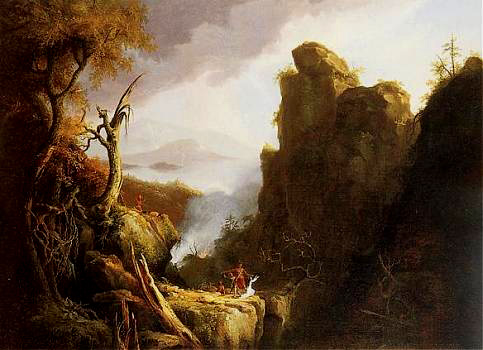
Thomas Cole, "Scene from The Last of the Mohicans" [The Death of Cora] (1827).
Cora (in white) prepares to escape the Indians by leaping off the
cliff in
James Fenimore Cooper's novel The Last of the Mohicans.
See also another Last of the Mohicans scene by Cole.
Durand biography--linked to many images at the bottom of the page.
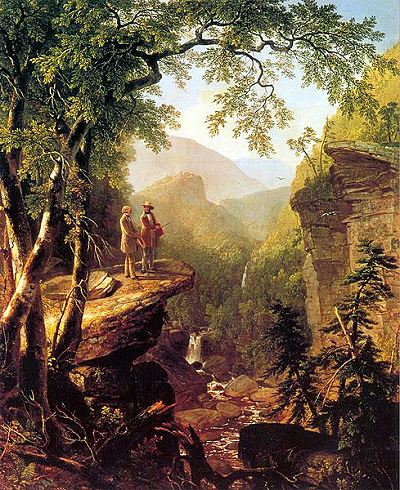
Asher B. Durand, "Kindred Spirits" (1849).
Large image available here.
The two men in the painting are Durand's good friends--the artist Thomas Cole and the poet William Cullen Bryant. Read more about their friendship and the painting: Intimate Friends: Thomas Cole, Asher B. Durand, and William Cullen Bryant. Here is a copy of Bryant's poem about Thomas Cole, plus a short biography of the writer and a copy of another Bryant poem, Monument Mountain, set in a scene similar to the one shown in this painting.
Sonnet - To Cole, the Painter Departing for Europe
by William Cullen Bryant
Thine eyes shall see the light of distant skies:
Yet, COLE! thy heart shall bear to Europe's strand
A living image of thy native land,
Such as on thy own glorious canvass lies.
Lone lakes--savannas where the bison roves--
Rocks rich with summer garlands--solemn streams--
Skies, where the desert eagle wheels and screams--
Spring bloom and autumn blaze of boundless groves.
Fair scenes shall greet thee where thou goest--fair,
But different--everywhere the trace of men,
Paths, homes, graves, ruins, from the lowest glen
To where life shrinks from the fierce Alpine air.
Gaze on them, till the tears shall dim thy sight,
But keep that earlier, wilder image bright.
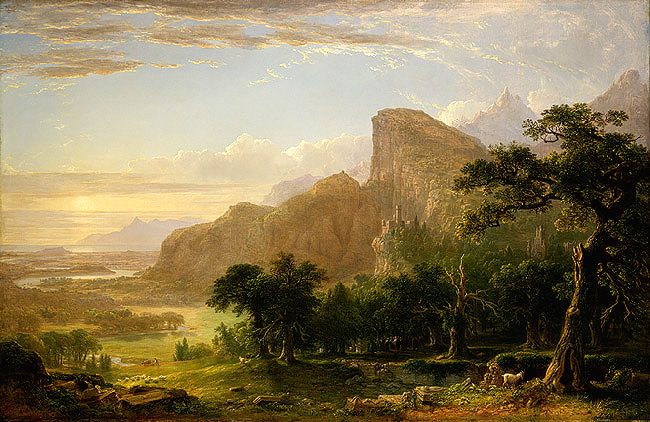
Asher B. Durand, "Thanotopsis" (1849). Based on
William Cullen Bryant's poem (online copy) by the same name.
from Thanotopsis
by William Cullen Bryant
. . . .
So live, that when thy summons comes to join
The innumerable caravan which moves
To that mysterious realm, where each shall take
His chamber in the silent halls of death,
Thou go not, like the quarry-slave at night,
Scourged to his dungeon, but, sustained and soothed
By an unfaltering trust, approach thy grave
Like one who wraps the drapery of his couch
About him, and lies down to pleasant dreams.
In Search of The Promised Land--longer gallery review article about Church; features many of his paintings.
Church biography--linked to many images at the bottom of the page.

Frederick Church,"Niagara Falls" (1857).
Nearly 8 ft. wide. Large image available here.
Read Margaret Fuller's description of visiting Niagara (from Summer on the Lakes, Chapter 1).
from Summer on the Lakes, Chap. 1: Niagara
by Margaret Sanger
The moonlight gave a poetical indefiniteness to the distant parts of the waters, and while the rapids were glancing in her beams, the river below the falls was black as night, save where the reflection of the sky gave it the appearance of a shield of blued steel. No gaping tourists loitered, eyeing with their glasses, or sketching on cards the hoary locks of the ancient river god. All tended to harmonize with the natural grandeur of the scene. I gazed long. I saw how here mutability and unchangeableness were united. I surveyed the conspiring waters rushing against the rocky ledge to overthrow it at one mad plunge, till, like toppling ambition, o'erleaping themselves, they fall on t'other side, expanding into foam ere they reach the deep channel where they creep submissively away.

Frederick Church, "Twilight in the Wilderness" (1859).
About 5 ft. wide. Large image available here.
Read some commentary.
Check out some similar Emily Dickinson sunset poems (her brother collected
Hudson River paintings.):
Whole Gulfs--of red;
How the old Mountains drip with Sunset;
Like Mighty Footlights;
or Red Sea, Indeed!.
Whole Gulfs—of Red, and Fleets—of Red—
by Emily Dickinson
Whole Gulfs—of Red, and Fleets—of Red—
And Crews—of solid Blood—
Did place upon the West—Tonight—
As 'twere specific Ground—
And They—appointed Creatures—
In Authorized Arrays—
Due—promptly—as a Drama—
That bows—and disappears—

Frederick Church, "Cotopaxi" (1862).
About 7 ft. wide. Large image available here.
See America's Moral Volcano--commentary on the
Civil War imagery in this painting.
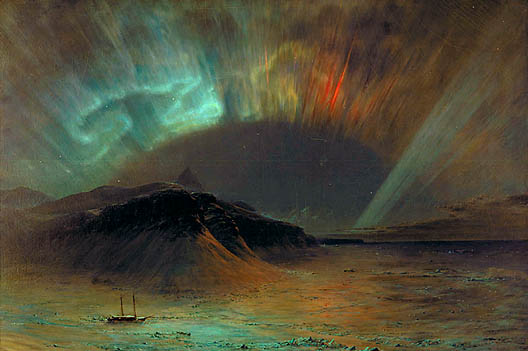
Frederick Church, "Aurora Borealis" (1865).
About 7 ft. wide. Large image available here.
Read commentaryon this painting.
Try Emily Dickinson's version of the northern lights: Of Bronze--and Blaze.
Of Bronze—and Blaze—
by Emily Dickinson
Of Bronze—and Blaze—
The North—Tonight—
So adequate—it forms—
So preconcerted with itself—
So distant—to alarms—
And Unconcern so sovereign
To Universe, or me—
Infects my simple spirit
With Taints of Majesty—
Till I take vaster attitudes—
And strut upon my stem—
Disdaining Men, and Oxygen,
For Arrogance of them—
My Splendors, are Menagerie—
But their Completeless Show
Will entertain the Centuries
When I, am long ago,
An Island in dishonored Grass—
Whom none but Beetles—know.

Frederick Church, "Rainy Season in the Tropics" (1866).
About 7 ft. wide. Large image available here.
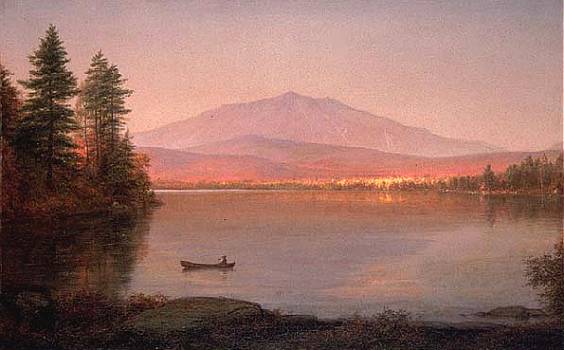
Frederic Church, "Mount Katahdin from Millinocket Camp" (1895).
See also an 1853 version called Mt. Ktaadn and another version from 1856.
Read Thoreau's account of climbing Mt. Ktaadn (from The Maine Woods).
Read this interesting commentary about Thoreau's attempt to scale the
majestic mountain:
When Thoreau Went Nuts on Maine's Mt. Katahdin.
from The Maine Woods [from the Kataadn passage]
by Henry David Thoreau.
It is difficult to conceive of a region uninhabited by man. We habitually presume his presence and influence everywhere. And yet we have not seen pure Nature, unless we have seen her thus vast and drear and inhuman, though in the midst of cities. Nature was here something savage and awful though beautiful. I looked with awe at the ground I trod on, to see what the Powers had made there, the form and fashion and material of their work. This was that Earth of which we have heard, made out of Chaos and Old Night. . . . It was Matter, vast, terrific,--not his Mother Earth that we have heard of, not for him to tread on, or be buried in,--no, it were being too familiar even to let his bones lie there,--the home, this, of Necessity and Fate. There was clearly felt the presence of a force not bound to be kind to man.
Kensett biography--linked to many images at the bottom of the page.

John Frederick Kensett, "Near Sunset" (c. 1850).
Focus on hazy light and atmosphere is typical of the later "luminist"painters.
See two hazy autumn-lit poems by Emily Dickinson:
As Imperceptibly as Grief
and These are the days.
As imperceptibly as Grief
by Emily Dickinson
As imperceptibly as Grief
The Summer lapsed away—
Too imperceptible at last
To seem like Perfidy—
A Quietness distilled
As Twilight long begun,
Or Nature spending with herself
Sequestered Afternoon—
The Dusk drew earlier in—
The Morning foreign shone—
A courteous, yet harrowing Grace,
As Guest, that would be gone—
And thus, without a Wing
Or service of a Keel
Our Summer made her light escape
Into the Beautiful.
Heade biography--with links to images of Heade's paintings.
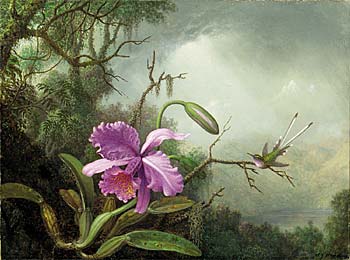
Martin Johnson Heade, "Orchid and Hummingbird" (c. 1885).
Here's Emily Dickinson's version of another otherworldly hummingbird. And
see some interesting commentary on this poem: The Hummingbird Symbol.
A Route of Evanescence
by Emily Dickinson
A Route of Evanescence
With a revolving Wheel –
A Resonance of Emerald –
A Rush of Cochineal –
And every Blossom on the Bush
Adjusts its tumbled Head –
The mail from Tunis, probably,
An easy Morning's Ride –
Bierstadt biography--linked to many images at the bottom of the page.
For Bierstadt's Eyes Alone--a detailed discussion of Bierstadt's art.
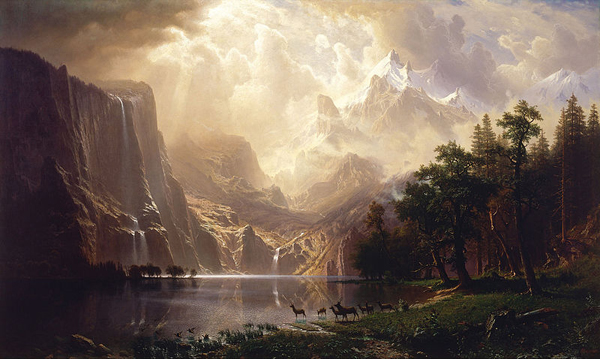
Albert Bierstadt, "Among the Sierra Nevada Mountains, California" (1868).
About 10 ft. wide. Note the deer gathered at the water's edge.
Large image available at Smithsonian.

Albert Bierstadt, "The Oregon Trail" [or "Emigrants Crossing the Plains"] (1868).
Nearly 9 ft. wide. The march of civilization toward
the golden West. Large image available here.
Inness biography--many image links at the bottom of the page.

George Inness, "Lackawanna Valley" (1856)
Large image available here.
Both this painting and the previous one are sometimes used to illustrate the intrusion of civilization and technology (the train/wagon-train and all it implies about the advance of civilization, moving westward) into the natural landscape. Were the Hudson River Valley painters pro-nature or pro-progress? The answer is not so clear. See this assessment: The Serpent in the New Eden: Technology and the Hudson River School.
Here is Emily Dickinson's treatment of some of these themes: I like to see it lap the Miles. The critic Harold Bloom says that Dickinson's poem "is one of the very few in which Dickinson examined a current technology, and points out that its theme is the effect such a technology may have on the landscape, and on people and animals. Bloom observes that the reader discovers the subject of the poem is a train by "seeing and hearing it, instead of being told directly."
I like to see it lap the Miles
by Emily Dickinson
I like to see it lap the Miles —
And lick the Valleys up —
And stop to feed itself at Tanks —
And then — prodigious step
Around a Pile of Mountains —
And supercilious peer
In Shanties — by the sides of Roads —
And then a Quarry pare
To fit it's sides
And crawl between
Complaining all the while
In horrid - hooting stanza —
Then chase itself down Hill —
And neigh like Boanerges —
Then — prompter than a Star
Stop — docile and omnipotent
At it's own stable door —
STUDY QUESTIONS: Which Hudson River paintings did you like best? Why? Describe some of the features you liked best. Are the images realistic or idealistic? What view of nature and of our relationship to nature is implied by these paintings? Is the primary effect eco-centric or anthropocentric? Are the artists celebrating the awesome beauty of nature, or are they projecting human needs and beliefs into the landscapes?
Hudson River Resources for Further Study:
Go to Hudson River Art, Part II: Women Artists
Return to Nichols Home Page
Additional Art Resources:
Comments/Suggestions: knichols11@cox.net
Last updated: 2-27-17